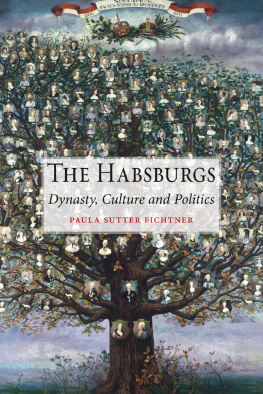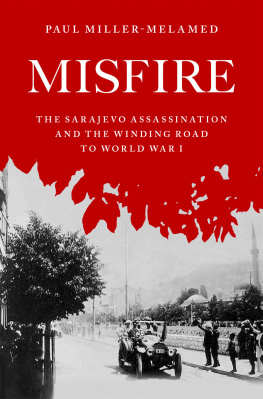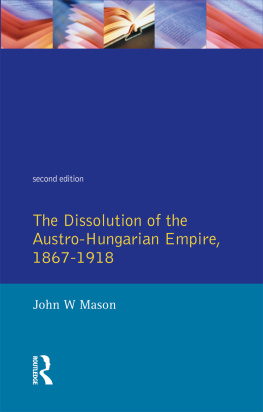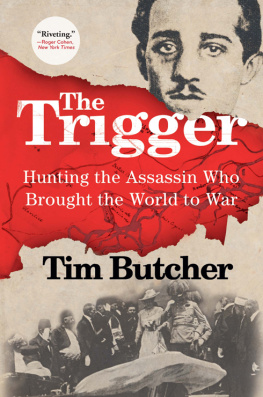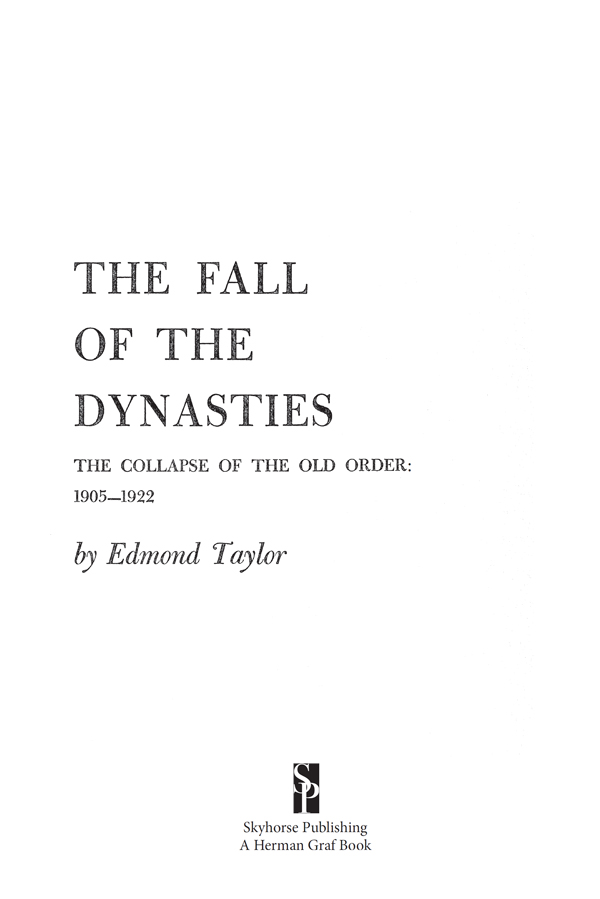
First published in 1963
First Skyhorse Publishing edition 2015
All rights to any and all materials in copyright owned by the publisher are strictly reserved by the publisher. All inquiries should be addressed to Skyhorse Publishing, 307 West 36th Street, 11th Floor, New York, NY 10018.
Skyhorse Publishing books may be purchased in bulk at special discounts for sales promotion, corporate gifts, fund-raising, or educational purposes. Special editions can also be created to specifications. For details, contact the Special Sales Department, Skyhorse Publishing, 307 West 36th Street, 11th Floor, New York, NY 10018 or info@skyhorsepublishing.com.
Skyhorse and Skyhorse Publishing are registered trademarks of Skyhorse Publishing, Inc., a Delaware corporation.
Visit our website at www.skyhorsepublishing.com.
10 9 8 7 6 5 4 3 2 1
Library of Congress Cataloging-in-Publication Data is available on file.
Cover design by Brian Peterson
Cover illustration is of the assassination of Franz Ferdinand and was published in Le Petit Journal in 1914.
Print ISBN: 978-1-63450-601-4
Ebook ISBN: 978-1-5107-0051-2
Printed in the United States of America
Acknowledgments
My greatest debtan immense onefor help on this book is to my wife, Anne V. Taylor, who in addition to offering sound criticism and encouragement at every stage of its preparation carried a large part of the burden of research and collaborated in writing several of the key chapters, notably . I naturally owe a particular debt for encouragement, criticism, and advice to John Gunther. I am also indebted for research and advice on several sections to Dr. Elsa Bernaut, Beata Levy, and Waverley Root, and to Eleanor Ohman, who also gave devoted secretarial assistance. I am deeply grateful to Manes Sperber for detailed and invaluable comments on the entire manuscript, and to Dr. Max Ascoli who offered several excellent suggestions for its improvement.
Contents
Maps and Genealogical Charts by Rafael Palacios
CHAPTER 1
Sarajevo: The Shots That Still Ring Round the World
O NE of the last known photographs of the Archduke Francis Ferdinand of Habsburg, heir to the throne of his uncle, the octogenarian Emperor Francis Joseph of Austria-Hungary, shows him coming down the steps of the city hall in Sarajevo a few minutes after eleven on the morning of Sunday, June 28, 1914. Under the refulgent uniform topped with a plumed hat his stout body is rigid; his heavy features seem congested and his neck swollen above the tight-fitting collar; his thick, curling mustaches bristle like a wild boars. Beside him walks his morganatic wife Sophie, the Duchess of Hohenberg, her plump face looking pinched and taut. They are just about to step into a waiting car. Both are clearly uneasy, but not yet really frightened. The local Bosnian dignitaries who line the steps, framing the doomed couple, are not frightened either; many of them are Moslemsparadoxically the only friends the Catholic Habsburgs have in this seething, semi-Oriental province, only recently freed from the Turkish yoke, but already clamoring for a Yugoslavia which has not yet been bornand they know that man does not evade his fate. The knowledge is written on their faces; the photograph catches them with their gloved hands raised to their flower-pot hats in a gesture of awe and resignation, as one salutes a funeral.
The whole scene, captured for posterity by some anonymous cameraman, stands out so vividly across the years that in looking at it one almost has the impression of reliving a personal nightmare. As in certain nightmares, incredulity wrestles with the sense of doom. Surely someone will cry out a warning before it is too late, surely someone will try to do something. In fact, someone does, but it is the wrong thing, and already it is too late. In five minutes Francis Ferdinand and Sophie will be lying unconscious in their speeding car bleeding to death from an assassins bullets: an ancient dynastyand with it a whole way of lifewill start to topple; then another and another and another. Close to nine million men fell in World War I as a direct result of those two shots fired in a dusty Balkan town roughly half a century ago; then 15,000,000 more in a second, greater conflict implicit in the ending of the first one. The visit that the Habsburg heir and his wife paid to Sarajevo lasted only a little more than an hournot quite the length of a normal feature filmbut the drama of those 60 or 70 minutes has literally revolutionized the whole course of modern history; reconstructing it helps to understand many of the tragic dramas that humanity has witnessed since.
The view of Sarajevo as one approaches from the southwest is a lovely one. High but gently sloping mountains almost encircle it. The valley of the Miljacka, a shallow torrent that cuts the town in two, narrows at its eastern outskirts to a rugged gorge commanded by the ruined Turkish fort (serai) from which it takes its name. The old Moslem quarters crown the upper slopes of the natural amphitheater that rises nearly six hundred feet on both banks of the stream; the slender minarets of their hundred mosques soar like rhythmed prayer above whitewashed villas in walled, tangled gardens. The raw modern town below merely serves as a foil to their enchantment. This is Sarajevo today, and thissave for the faint scars left by Allied bombing in World War IIis how it appeared to Francis Ferdinand in the clear morning sunlight, as his open-topped car, with the gold and black fanion of the Habsburgs fluttering in the fresh mountain air, drove into town from the railroad station.
Though not a man normally sensitive to beauty, the archduke no doubt was gladdened by the scene. He demonstrated no more enthusiasm than he habitually displayed at the opera or at Court ballsa constant complaint of the artistic and pleasure-loving Viennesebut as he leaned stiffly against the leather-upholstered seat condescending to the view, his arrogant, morose face, with the sagging middle-aged jowlshe was fifty-oneseemed unusually cheerful. Francis Ferdinand had in fact every reason to be satisfied with life, and even to feel a little mellow that June morning. The ostentatious, almost provocative, military maneuvers along the Serbian border that had been the official pretext for his visit to Bosniahe was Inspector General of the armed forceshad gone off well, at least from the Austro-Hungarian viewpoint. For once there had been no slacknessnothing like that disgraceful incident a couple of months earlier near Trieste when he had personally caught one of the sailors from his naval guard sneaking a cigarette behind a hedge (he had had the fellow put in the brig for a fortnight). Francis Ferdinand was a humorless, taciturn martinet with a mania for spit-and-polish who also took seriously the serious side of soldiering and administration; he had an almost Prussian phobia about schlamperei, the Austrian genius for insouciant inefficiency. The royal suite in the hotel of the little spa, Ilidze, where he had spent the previous night had been quite comfortableno schlamperei there, eitherand Sophie, whom he had brought along with him, in violation of all protocol, had enjoyed the respectful attentions of his young staff officers. The ceremonial visit to Sarajevo, promised, for all its tedium, to be even more satisfying; its timing had a private significance that in the Archdukes mind may possibly have overshadowed the political one. June 28 was the anniversary of the most important date in his life.
Fourteen years ago on that day, Archduke Francis Ferdinand of Austria-Este (as he preferred to call himself) had married Countess Sophie Chotek, a member of a noble but comparatively obscure Czech family, and a lady-in-waiting to his cousin, the Archduchess Isabella. From the Habsburg viewpoint she might as well have been a chambermaid. Love makes people lose all sense of dignity, Francis Joseph exclaimed when he heard the news. The old Emperor had never quite forgiven his heir for this misalliance; it had taken a whole year of stubborn negotiations to win his consent to the marriage. But even Francis Joseph could not have softened the iron writ of Habsburg House Law, the supreme code of the dynasty. At a solemn assembly of the Court and the Privy Council in the ancient Hofburg Palace in Vienna, Francis Ferdinand had been obliged to renounce all rights of rank and succession for his children before taking Sophie as his morganatic wife. He had never forgotten the humiliation. He loved Sophie enough to swallow it, but it rankled all the same. The Archduke was no royal iconoclast or bohemian; he was a snob and a pedant obsesseddespite his marriage to a commonerwith the privileges of royalty generally and with his own dynastic rights in particular.
Next page

